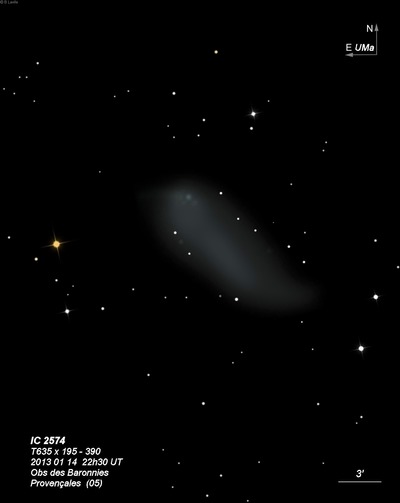Coddington's Nebula
Coddington's Nebula

Edwin Coddington discovered IC 2574 at Lick Observatory on a plate of the M81/82 region taken on 17 and 20 Apr 1898 with the 6" Crocker telescope (Willard Lens). The discovery was announced in PASP 10, 123 (1898). Coddington noted he observed it visually on the 22nd with the 12-inch refractor. Also, on 19 May, Coddington obtained an additional photograph that showed "the different condensations to be connected by faint nebulous matter, and the whole to extend over an area fully 4' in width and 12' in length."
400/500mm - 17.5" (3/12/94): faint, very large, elongated 5:2 SW-NE, 7.0'x2.5', low surface brightness, no concentration. Four faint stars are near the north side. There is a fairly bright nonstellar HII region that is clearly visible at the NE end as a high surface brightness knot. Member of the M81 group (distance ~12 million l.y.).
900/1200mm - 48" (2/21/12): This large, low surface brightness dwarf irregular in the M81 group extended roughly 10'x4' SW-NE with only a weak, broad concentration. The galaxy is dominated by a giant star forming/HII complex near the NE end of the galaxy. At 375x, four separate, compact knots were easily resolved within a 1.2' region, though the brighter glow from the entire complex spans roughly 1.5'x1.0' from WSW to ENE. The brightest and largest knot carries the designation IC 2574:[HK83] #15, from Hodge and Kennicutt's "An Atlas of H II regions in 125 Galaxies" in AJ, 88, 296 (1983). This high surface brightness knot is very bright, slightly elongated N-S, 20"x15", and is situated at the NW vertex of the four knots. #13/34 is a fainter irregular knot of ~12" diameter at the NE vertex. #35 forms the SE vertex and appears as a faint, round knot, only 8"-10" in size, just 24" SSW of #13/#34. The knot at the SW vertex is not listed in the H-K atlas, but is catalogued in NED as radio source NVSS J102844+682809. It appeared similar to #35, though slightly elongated and situated only 20" S of #15. At 488x, a 5th knot was seen ~30" SW of #15, and appeared as a very faint, ill-defined 15" glow (this region contains #17 and #19).
Notes by Steve Gottlieb